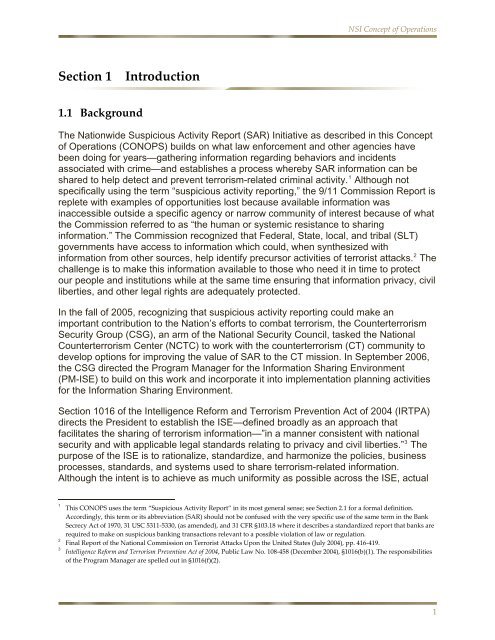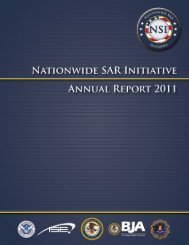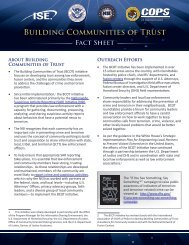NSI Concept of Operations Version 1, December 2008
NSI Concept of Operations Version 1, December 2008
NSI Concept of Operations Version 1, December 2008
Create successful ePaper yourself
Turn your PDF publications into a flip-book with our unique Google optimized e-Paper software.
<strong>NSI</strong> <strong>Concept</strong> <strong>of</strong> <strong>Operations</strong><br />
Section 1<br />
Introduction<br />
1.1 Background<br />
The Nationwide Suspicious Activity Report (SAR) Initiative as described in this <strong>Concept</strong><br />
<strong>of</strong> <strong>Operations</strong> (CONOPS) builds on what law enforcement and other agencies have<br />
been doing for years—gathering information regarding behaviors and incidents<br />
associated with crime—and establishes a process whereby SAR information can be<br />
shared to help detect and prevent terrorism-related criminal activity. 1 Although not<br />
specifically using the term “suspicious activity reporting,” the 9/11 Commission Report is<br />
replete with examples <strong>of</strong> opportunities lost because available information was<br />
inaccessible outside a specific agency or narrow community <strong>of</strong> interest because <strong>of</strong> what<br />
the Commission referred to as “the human or systemic resistance to sharing<br />
information.” The Commission recognized that Federal, State, local, and tribal (SLT)<br />
governments have access to information which could, when synthesized with<br />
information from other sources, help identify precursor activities <strong>of</strong> terrorist attacks. 2 The<br />
challenge is to make this information available to those who need it in time to protect<br />
our people and institutions while at the same time ensuring that information privacy, civil<br />
liberties, and other legal rights are adequately protected.<br />
In the fall <strong>of</strong> 2005, recognizing that suspicious activity reporting could make an<br />
important contribution to the Nation’s efforts to combat terrorism, the Counterterrorism<br />
Security Group (CSG), an arm <strong>of</strong> the National Security Council, tasked the National<br />
Counterterrorism Center (NCTC) to work with the counterterrorism (CT) community to<br />
develop options for improving the value <strong>of</strong> SAR to the CT mission. In September 2006,<br />
the CSG directed the Program Manager for the Information Sharing Environment<br />
(PM-ISE) to build on this work and incorporate it into implementation planning activities<br />
for the Information Sharing Environment.<br />
Section 1016 <strong>of</strong> the Intelligence Reform and Terrorism Prevention Act <strong>of</strong> 2004 (IRTPA)<br />
directs the President to establish the ISE—defined broadly as an approach that<br />
facilitates the sharing <strong>of</strong> terrorism information—”in a manner consistent with national<br />
security and with applicable legal standards relating to privacy and civil liberties.” 3 The<br />
purpose <strong>of</strong> the ISE is to rationalize, standardize, and harmonize the policies, business<br />
processes, standards, and systems used to share terrorism-related information.<br />
Although the intent is to achieve as much uniformity as possible across the ISE, actual<br />
1<br />
2<br />
3<br />
This CONOPS uses the term “Suspicious Activity Report” in its most general sense; see Section 2.1 for a formal definition.<br />
Accordingly, this term or its abbreviation (SAR) should not be confused with the very specific use <strong>of</strong> the same term in the Bank<br />
Secrecy Act <strong>of</strong> 1970, 31 USC 5311‐5330, (as amended), and 31 CFR §103.18 where it describes a standardized report that banks are<br />
required to make on suspicious banking transactions relevant to a possible violation <strong>of</strong> law or regulation.<br />
Final Report <strong>of</strong> the National Commission on Terrorist Attacks Upon the United States (July 2004), pp. 416‐419.<br />
Intelligence Reform and Terrorism Prevention Act <strong>of</strong> 2004, Public Law No. 108‐458 (<strong>December</strong> 2004), §1016(b)(1). The responsibilities<br />
<strong>of</strong> the Program Manager are spelled out in §1016(f)(2).<br />
1






